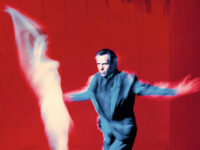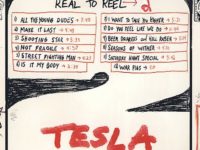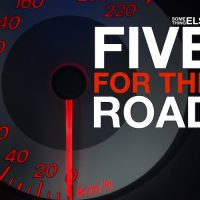Best-of albums are starting to make sense to me. Is that nostalgia? Or perhaps I’m just getting old.
I found myself, for instance, intrigued by a comprehensive 2-disc solo career-spanner from Robert Plant in the form of Sixty-Six To Timbuktu. He’s an artist who has released of number of great songs, but whose albums fell short of necessary to me, as they always proved more spotty than not. Then, there’s former King Crimson Warr-guitarist Trey Gunn, whose solo career was sufficiently short that, at that point, a best-of actually proved a fairly smooth listen. (It doesn’t hurt that the disc was packed with a DVD of assorted live and other material.)
In these cases, a best-of might be a great way to go. Still, to me, similar projects used to more often represent the final nail in an artist’s coffin — either as the contract-filler of an artist desperately wanting to move on to the greener pasters of a better record label or as a last-ditch attempt to garner a few more sales for a recently broken-up/dead/crappy artist. These compilations generally are simply a compromise: a bunch of the well-known songs collected together to sell to those people who likely wouldn’t have ever bothered buying a regular album by an artist.
Of course, they’re usually packed with at least one or two “previously unreleased” tracks that will rope in the fans who already have everything else. Particularly wily bands and labels will weave together the kind of best-of that usually angers everyone — one that has some of the artist’s best songs and then a bunch of oddities that were barely acceptable as b-sides. Once in a while it works (as was the case, for instance, with R.E.M’s In Time) but more often than not it’s just a severe compromise that suits no one. So, usually, I’m content to leave best-ofs to the casual fan, as it’s a rare thing that I’m a casual fan of anything, and even the promise of a couple new tracks doesn’t raise much interest in me.
[SOMETHING ELSE! REWIND: A five-song spin through Peter Gabriel’s always-intriguing solo career, featuring both charting favorites and a few forgotten gems.]
Until lately, that is. Now, maybe because my time is becoming more scarce, I’m finding a useful niche for best-of compilations, a sad realization that I worry will have me picking up Michael Bolton Christmas collections at some point in the less-distant-than-I’d-like-it-to-be future. I simply find it easier in some cases to grab a best-of instead of a couple of, or even all releases by a band to feed my need for a fix — a bit of this, a bit of that …
That was the case, ultimately, with Peter Gabriel’s remastered collection, titled Hit. (Disc one included his charting tunes, while disc two — titled Miss — featured album cuts). I was only missing a couple of the entries here — and of those missing was Shaking The Tree, a mid-period best-of that pulled off the feat fairly well. Nonetheless, I had forsaken this to the used-CD store long ago, as I began gathering his albums one by one. As I’d prefer to hear songs in their proper context, nestled among other songs born into the world at about the same time, best-ofs have little use to me. An artist with a career as varied and long as Gabriel’s presents a problem for best-of releases, anyway: How to pair songs from 1977 with songs from today. With songs careening from off-kilter post-prog rock oddness to electronics- and beat-heavy world-music, flow becomes an issue.
The best best-ofs favor a realistic timeline for the structure of the tracklisting. Begin with the earliest and progress song by song to the latest. Or do the opposite, as in the case of Iron Maiden’s 2-disc Best Of The Beast, for an interesting “looking back” perspective. Some more interesting, experimental artists aren’t content with simply compiling their best and set out to improve. I think we all know how wrong that can go from the example when the Police “reunited” to re-record “Don’t Stand So Close To Me,” stamped the “’86” label on it, and proved exactly what killed the Police off in the first place: They’d forgotten how to make great music together.
However, some artists have pulled this off, too. David Sylvian, ex-crooner of new-wave pioneers Japan, managed to dig through his catalog and find a number of tracks that he felt he could improve upon. The result was less a best-of than an intriguing story about the artist in that moment. Forward, backward, or all mixed up, the result works: Sylvian’s Everything And Nothing instantly became one of the most compelling works in his catalog.
[SOMETHING ELSE! REWIND: Peter Gabriel’s ‘Bad Blood: Live in London’ gives us a deeper appreciation for what he’s trying to do with his music now — that is to say, growing older and doing it very gracefully.]
The worst, the most annoying, simply appear to have tracks from every era all thrown together. Sure, maybe some attempt has been made to find a logical path from one song to another — songs are either in a similar key or have a similar beat — but the effect is always jarring because most back-to-back songs sound drastically different, having been recorded by different producers in different studios, often with different musicians. No matter how great the material, the mixture of eras, sound quality, and musicians leads to a weakened presentation. Such is unfortunately the case with Peter Gabriel’s Hit, which was jam-packed with classic after classic, two soundtrack-only songs, a live track, and even a great new song as well. There was even a couple of new mixes to freshen things up. But in the end, the “grab songs out of a hat” approach to the tracklisting was less pleasing than I’d hoped.
I could even have been swayed a bit more by great liner notes, with stories detailing some interesting tidbits about each song, but Hit simply displayed a listing of who-played-what and publishing info. To knock a few more points off my score, the artwork, while classy and minimal, wound up being more than just a little annoying. When you pack 29 tracks onto two discs, most people would prefer to see some semblance of numbering to make finding that particular classic you need to hear right now easier to find. I found out how annoying this was when driving down the road after I picked up Hit. I really just wanted to hear new track “Burn You Up Burn You Down” and had to balance dodging other drivers with counting songs (it’s track 7, in case it helps you.) Even worse, there’s no distinction between what is “Disc 1” material and what is “Disc 2” material. Somewhere, in the giant block of 29 song titles, is a break between the two discs (“San Jacinto” starts Disc 2, if it helps you.)
Still, a quick fix is a quick fix, and for many, dealing with the oddness of Gabriel’s output may be too much to handle. As great as his albums may be, they are more suited to those who want to sit and listen intently. His catalog is filled with great, thoughtfully constructed pieces, but he has enough “hits” that casual fans may find themselves frustrated with his restless experimental streak. In this case, the ups-and-downs of a set like Hit will probably prove inconsequential. For the rest of us, however, the albums will more than please us, and Hit will likely continue to be something to fill out the blanks of his catalog with the few rarities it offers.
[amazon_enhanced asin=”B0000DZ3EA” container=”” container_class=”” price=”All” background_color=”FFFFFF” link_color=”000000″ text_color=”0000FF” /] [amazon_enhanced asin=”B003ZZAXEU” container=”” container_class=”” price=”All” background_color=”FFFFFF” link_color=”000000″ text_color=”0000FF” /] [amazon_enhanced asin=”B005HS00V4″ container=”” container_class=”” price=”All” background_color=”FFFFFF” link_color=”000000″ text_color=”0000FF” /] [amazon_enhanced asin=”B003ZZAXG8″ container=”” container_class=”” price=”All” background_color=”FFFFFF” link_color=”000000″ text_color=”0000FF” /] [amazon_enhanced asin=”B003YOXIVW” container=”” container_class=”” price=”All” background_color=”FFFFFF” link_color=”000000″ text_color=”0000FF” /]
- How David Bowie’s ‘Reality’ Stood Out For What It Was Not - September 29, 2023
- Metallica’s ‘St. Anger’ Was Always Much Better Than They Said - June 8, 2023
- How King Crimson Defined an Unsettled Post-9/11 Landscape on ‘Power to Believe’ - March 5, 2023




